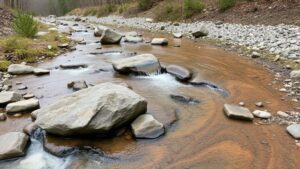Simple Methods for Identifying Gold in Arid Region Gravel Deposits
Simple Methods for Identifying Gold in Arid Region Gravel Deposits
The identification and extraction of gold from gravel deposits in arid regions present unique challenges and opportunities. These environments, characterized by low moisture and often extreme temperatures, require specific techniques that leverage both traditional and modern methods. This article explores simple methods for identifying gold in these deposits, providing practical insight for prospectors and mineral enthusiasts alike.
The Importance of Field Study
Before diving into methods of identification, it is critical to understand the context of gold deposits. Field studies not only prepare the prospectors for effective searching but also establish an understanding of geological formations that typically harbor gold. In arid regions, observing the geology can provide valuable clues.
- Look for signs of erosion which often exposes gravels rich in heavy minerals.
- Identify quartz veins or other indicators, as these formations may lead to gold deposits.
Panning Techniques
Panning is perhaps the most traditional and accessible method for identifying gold in gravel deposits. This technique can be used effectively even without specialized equipment.
- Begin by gathering a sample of gravel from a likely area, such as near the base of a slope.
- Using a pan, add water and carefully swirl the contents to allow the heavier materials, including gold, to settle to the bottom.
- Continue to wash away lighter materials until only the heaviest particles remain.
In areas recognized for historical gold finds, such as parts of Nevada and California, prospectors have recorded success rates of around 1 in 50 pans yielding visible gold flakes, underscoring the potential of this method.
Using a Metal Detector
Modern advancements in technology have enabled the use of metal detectors to identify gold deposits with higher accuracy. Metal detectors designed to search through highly mineralized soils are particularly effective in arid environments.
- Choose a metal detector that operates at a frequency suitable for detecting gold.
- Scan areas previously identified as potential hotspots for gold, such as riverbeds and ancient stream channels.
According to the World Gold Council, metal detecting has become a popular method, with many hobbyists finding significant gold nuggets in western U.S. states, often weighing several grams, showcasing the efficiency of this technique.
Visual Identification of Characteristics
Prospectors can improve their chances of finding gold by learning to recognize the physical characteristics of gold in nature. This involves understanding the different forms gold can take in gravel deposits.
- Gold nuggets are usually irregularly shaped and often exhibit a distinctive luster.
- Gold flakes may accompany quartz or pyrite, so having knowledge of these indicators can lead to successful identification.
For example, in Australia, many gold rush stories emphasize the discovery of easily visible nuggets, particularly during dry seasons when the ground is less disturbed.
Utilizing Basic Chemical Tests
For a more definitive identification of gold, basic chemical tests can be conducted in the field. While these methods require some equipment, they remain relatively simple to execute.
- Perform a streak test by rubbing a suspected gold sample against a ceramic plate to see if it leaves a yellow streak.
- Use nitric acid to test for golds resistance to corrosion, as it does not react to this acid while other metals do.
These methods provide additional confidence in confirming the presence of gold and are often used in conjunction with the preceding techniques.
Conclusion and Actionable Takeaways
Identifying gold in arid region gravel deposits requires a combination of historical knowledge and practical techniques. By employing simple methods such as panning, metal detection, visual identification, and basic chemical testing, prospectors can enhance their chances of success.
In sum, consider these actionable steps:
- Conduct field studies to understand the geological context.
- Leverage traditional methods like panning, coupled with modern tools like metal detectors.
- Familiarize yourself with the characteristics of gold to aid in visual identification.
- Be equipped with basic chemical testing supplies for on-site confirmations.
Armed with these techniques, prospectors can effectively navigate the challenges of arid regions in their quest for gold.



